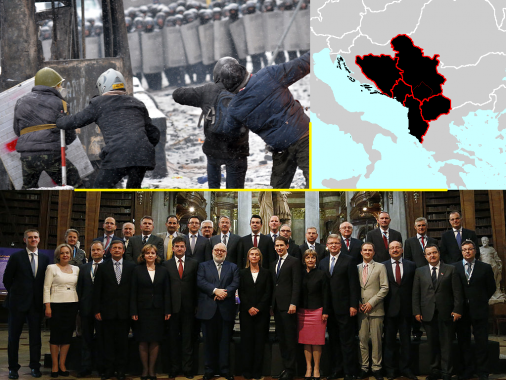This isn’t Ukrainian, yet Balkan scenario written by corrupted leaders
Published in Columns
on 9 - 06 - 2016 Author: Љубомир Костовски
There aren’t many western leaders who have the opportunity to stay in power for too long, to steal votes easily, to be without neat electoral rolls… Of course, corruption exists in the developed democratic societies, but it is noticed and punished. When it comes to us and some other countries around us, we witness a situation when the media very easily decide to go with the Ukrainian scenario as a trouble source of the political leaders, without reading the motives of the people who walk down the streets with dissatisfaction.
Author: Ljubomir Kostovski
The citizens in this region live in very similar conditions and with political elites keen on corruption and with evident deficit of democratic sense. This is the only explanation of the current situation which includes dissatisfied citizens strolling the streets in all parts of the subcontinent. All of this, of course, has nothing to do with any external influence and some pro-western plans, as one part of the newspapers and the TV/radio stations in the Balkans use to say. The term “Ukrainian scenario” is primarily used by the pro-governmental circles in this country in order to create dissemination of the “evil” attacking their party leader and the plutocracy around him, and it is not from the inside, yet brought here from the international circles, and by doing so, they would like to dodge the situation that they, with actions sourcing from Blvd. Ilinden No.2, enter in some Guinness book of “unique” solutions from the pre-politic era!
Let me put it this way, if the trench is extended from Tabanovce towards north and west, we get a virtual front that illustrates the endangered region. In such assertion, the domestic illustrators of such situation are supported only by Belgrade and Banja Luka, which have similar motives. Although, frankly speaking, the problems for the government are present everywhere, in every corner of the former SFRY and in neighboring Bulgaria, and in Greece of course, and not just nowadays, but for decades!
In fact, how can a Ukrainian scenario be mentioned when the regional crisis is older than the events at the Maidan Square in Kiev?! Let’s just remind ourselves to the riots in the Slovenian cities (December 2012) which were covered by the press throughout Europe. The protests started in Maribor. Everything began when more than 10.000 people were continuously requesting the resignation of the corrupted mayor Franc Kangler, although generally, the riots that spread throughout the entire country were caused by the dissatisfaction deriving from the social, economic and political conditions ruling in the country.
FORMER YUGOSLAVIA – SIMILAR PROBLEMS EVERYWHERE
The anti-government protests in Bosnia and Herzegovina from the spring of 2013 resulted from the high unemployment rate (nearly 40%) and widespread corruption. And whilst the authorities were assessing that the protestors were manipulated, the analysts believed that precisely these assessments show their fear from the people. The protests of dissatisfied workers and citizens began in Tuzla, and then spread in other cities. During these social riots in Bosnia and Herzegovina, biggest after the war in the 90s, more than 300 people were wounded, and the damage caused to the municipal buildings set ablaze is more than 25 million euro!
In Serbia, the leading politicians and media under governmental control were supporting Gruevski from many reasons up until the elections, but above all, because the Prime Minister Aleksandar Vuchich wished himself long-term practice of government, which has many sustainable parallels of system control (via the aforementioned media under his claws, by destroying the opposition local government, by nurturing all forms of populism familiar to us). Immediately before the elections, the rhetoric soothed and the fear of the “Colorful Revolution export” towards Belgrade stopped spreading, because they wanted to represent Serbia as the only stable country in the region. Some of our media, especially Vecher daily and Sitel TV station, look at Serbia like this, and they believe that the elections in Serbia saved this country from street riots, and these media offer the elections as our salvation too. However, the rhetoric about the Ukrainian scenario remained, albeit the old and new Prime Minister Vuchich says that when he speaks about Kiev scenario, he refers to our sources (“as they say”), meaning of us Macedonians.
However, soon after the elections, when the opposition started organizing protests because of the technology used by the government to affect the State Election Commission, the attitude for possible protests north from us has changed again, but at the end, it turned out that the opposition does not have the strength to mobilize the public opinion. So again, the Ukrainian scenario was mentioned again after the rumors that the Macedonian events will be copied in Banja Luka (Republika Srpska), under the influence of “western sponsors”. Event forged documents for alleged assistance from Soros for the opposition party were delivered there, but were quickly disclosed as set up news.
“Everyone, even those who faintly follow what’s happening in the region and in Europe, know that there are no grounds for comparison between Macedonian and Ukrainian scenario… the protestors in Skopje were throwing paint towards the governmental building” – wrote Jovana Dimitrijevich for the Belgrade Vreme weekly magazine.
What is similar between Republic of Serbian Krajina and Macedonia, of course, is the manner of the opposition when it reacts to the choice of the ruling party not to respect the agreed (is destroying the Dayton agreement), behaves absolutistically, and several banks started collapsing due to corruption. Alongside with the banks, plenty of bank account holders became debt slaves, without being guilty or whatsoever. The fact is that we transferred something across the border – Milorad Dodik from the Serbian Democratic Party organized counter-rallies with members of his party and with engaged “affiliates”.
Is there correspondence between the events in our country and in Republika Srpska and what are the grounds for it? It is not difficult to make conclusion on the grounds of this example only.
In fact, there were riots in Podgorica and in other Montenegrin cities. In October last year several thousand protestors were arriving in the capital of Montenegro. Without going any deeper in their justified or unjustified requests, it must be emphasized that the Belgrade government, the one of Vuchich, although not directly, but indirectly was supporting the parties of the Democratic Front which came out on the streets and stayed there for 20 days. As a matter of fact, some of those parties are part of the corpus of the so called pro-Russian and pro-Serbian lobby(!). Furthermore, a large number of the opposition press in Serbia was defending the protestors from violence, for instance the Newsweek weekly magazine, a Balkan clone of the eponymous weekly magazine in the US. Only by following this example, we can see how the thesis that somebody was disseminating Ukrainian scenario in Montenegro is easily destroyed (the crisis is still present there, although the actors had more sense for compromise in this case) because all traces from Montenegro lead further from the western countries?!
Finally, there is Croatia, if we speak about the countries created after the fall of SFRY, which is dealing with the current corruption affair involving the vice-president of the government and leader of the Croatian Democratic Union – Tomislav Karamarko, and this affair jeopardizes the government in this country and the alliance with “Most”. Although elections were recently held there (this goes for the ones who believe that if elections are held, there will always be peace and stability afterwards), they weren’t able to create a credible coalition even two months after the elections.
CORRUPTION – THE TRIGGER THAT MAKES THE PEOPLE REACT
But, the trigger to all riots on the Balkans is yet again the corruption present among the politicians and it makes the people react. The impoverished citizens, many of them on the verge of hunger, after the long transition believe that 25 years after the system change they gained nothing, and lost plenty, and that the ones who were supposed to bring the spirit of changes filled their pockets instead.
Later on, as Dragoljub Zharkovich recently said for the “Pressing” show airing on the regional N1 TV station, the Balkan leaders have the Putinesque-Lukashenkoesque manner for long term and unlimited ruling. The Montenegrin leader Milo Djukanovich was first a Prime Minister of Montenegro (1991 – 1998) then a President of this country (1998 – 2002), and again a Prime Minister (2003 – 2010)… Endless, of course.
The years in office of our Prime Minister reached the number of 10 with numerous snap elections (in fact no elections after the ones in 2006 were regular), an example followed by the Serbian leader Vuchich, after he burned the bridges with his fellow party member, the president Nikolich, Vuchich wants to take the presidential office on the next re-election!
We could find many other similarities present in the Balkan elites, however, it would not be easy to find such examples in the western countries. We would find such examples easier if we face towards the East.
This column was created within the framework of the USAID Media Strengthening in Macedonia Project - Media Fact-Checking Service Component,, mplemented by Metamorphosis. The column is made possible by the generous support of the American people through the United States Agency for International Development (USAID). The contents are the responsibility of its author and do not necessarily reflect the views of Metamorphosis, USAID or the United States Government. For more information on the work of USAID in Macedonia please visit its website (http://macedonia.usaid.gov) and Facebook page (www.facebook.com/USAIDMacedonia).


